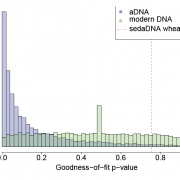eLife paper on assessing ancient DNA authenticity from low-coverage data
Contesting the presence of wheat in the British Isles 8,000 years ago by assessing ancient DNA authenticity from low-coverage data
Weiss, C..L., Dannemann, M., Pruefer K., Burbano, H.A.
Contamination with exogenous DNA is a constant hazard to ancient DNA studies, since their validity greatly depend on the ancient origin of the retrieved sequences. Since contamination occurs sporadically, it is fundamental to show positive evidence for the authenticity of ancient DNA sequences even when preventive measures to avoid contamination are implemented. Recently the presence of wheat in the United Kingdom 8000 years before the present has been reported based on an analysis of sedimentary ancient DNA (Smith et al. 2015). Smith et al. did not present any positive evidence for the authenticity of their results due to the small number of sequencing reads that were confidently assigned to wheat. We developed a computational method that compares postmortem damage patterns of a test dataset with bona fide ancient and modern DNA. We applied this test to the putative wheat DNA and find that these reads are most likely not of ancient origin.


